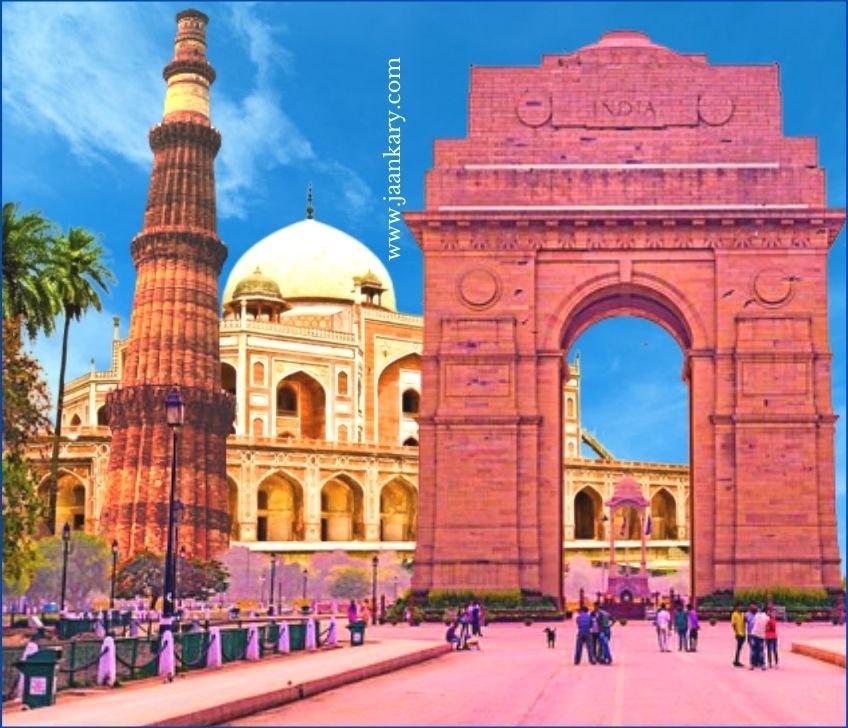QUTUB MINAR
Qutab Minar, Qutub Minar or Qutub Mina spell however you like. The spelling could be changed from historian to historian, but the building’s charm has remained the same throughout history. This 73-meter high minaret has five floors. Interestingly, the diameter at the base of the structure is 14.3 meters while it narrows to 2.7 meters towards the top.
Qutub Minar is inspired by the jam minaret that was built in Afghanistan. Qutab Ud-din Aibak, the founder of the Delhi Sultanate, is believed to have started building the minaret around 1192. He is credited with building the first floor of the five-story minaret. However, the task was taken up by Aibak’s son-in-law and successor, Iltutmish, who added three more floors to the minaret in 1220.
However, the Qutab Minar you see today was completed by Firoz Shah Tughlaq. In 1369, lightning destroyed the last floor built by Iltutmish. In addition to repairing the damaged floor, Tughlaq built another terrace over the building to complete it. Sher Shah Suri expanded the building again while Humayun was in exile. He also created an entrance for the minaret.
Qutub Minar is not the only place in the minar complex. It is surrounded by many places of historical importance. The Quwwat-ul-Islam mosque is in the same building and is as old as the minaret itself. There is an iron pillar that is very old and popular.
Let’s talk about the architecture of the minaret. As already mentioned, the makers were inspired by Jam’s Afghan minaret. Incorporating looped bells, lotus valances, and garlands into
your sculpture gives it the local effect. Qutub Minar has stood the test of time and rulers. The place is definitely worth visiting.
INDIA GATE
This 42 meter high triumphal arch in the heart of Delhi is much higher in the heart of India. The India Gate, formerly known as the All India War Memorial, was built to commemorate the deaths of 70,000 British and Indian soldiers who died in the First World War between 1914 and 21.
Although the Gateway of India was built as a war memorial, the architectural style makes it look like the epitome of triumph. Similar to the Arch of Constantine outside the Colosseum in Rome, the Gateway of India was designed by Sir Edward Lutyens.The India Gate received an additional structure in the form of a black marble pedestal with an inverted rifle with a soldier’s helmet after the Bangladesh Liberation War in 1971. It is called Amar Jawan Jyoti. India Gate is one of the most important war monuments in the country.
What we all know is that the India Gate occupies a central place in the history of India, but what many of us may not know is that the monument occupies an important place in the hearts of the people of Delhi. Whenever there is a need or reason to celebrate, India Gate is the place for it.People visit the place with their families to spend quality time together. Local grocery vendors add to the fun of spending time with family and friends.
HUMAYUN’s TOMB
The tomb of the Mughal Emperor Humayun, called Humayun’s Tomb, was built in Delhi in 1569-70. The construction of Humayun’s tomb was commissioned by his first wife and main wife, Empress Bega Begum.
It was designed by Mirak Mirza Ghiyas and his son Sayyid Muhammad with some Persian architects selected by the Begum. Humayun’s Tomb is located in Nizamuddin East and is the first garden tomb in the Indian subcontinent. Humayun Tomb was declared in 1993 UNESCO World Heritage Site.
The Humayun Tomb complex houses not only the tomb of Emperor Humayun, but also the tombs of Bega Begum, Hamida Begum and also Dara Shikoh, grandson of Emperor Humayun and son of Emperor Shah Jahan. The construction of the tomb is a perfect showcase of Mughal architecture and its development.
In addition to the main building, the Charbagh Gardens of Humayun’s Tomb are also a major attraction. Built in the typical Persian style, these gardens serve as resting places for visitors.
Humayun’s Tomb was erected in the Nizamuddin area of Delhi. This location was chosen given the proximity to the location of Nizamuddin Dargah, the mausoleum of Saint Sufi Hazrat Nizamuddin.
The architecture of Humayun’s tomb is quite impressive. This fascinating architecture is a true model of the Persian styles of Islamic architecture. The tomb is approximately 47 meters high and 91 meters wide. The dome of Humayun’s tomb is a special attraction.The exterior of the Humayun Tomb is simple and symmetrical.. So be sure to mark the spot on your list when visiting Delhi
LAL QILA (RED FORT)
The Red Fort, popularly known as Lal Qila, is the pride of the nation. It is a historical fortress that is located in the oldest part of the city. Lal Qila was the main residence of the Mughal emperors who ruled the city for about 200 years. The Mughals lived in Lal Qila until 1856. In addition, the historical monument also served as the political center of the Mughals.
The Red Fort was built during the reign of Mughal Emperor Shah Jahan in 1639. It was inspired by Shah Jahan’s palace in his walled capital, Shahanabad. Due to its huge closed walls of red stone, it was called the Red Fort. The palace not only shows the architectural brilliance of Shah Jahan, but it also offers a pretty good picture of Islamic architecture from that time.
Located in the center of Delhi, Lal Qila is home to many museums and pavilions. Each pavilion of Lal Qila speaks volumes about the bravery and pomp of the Mughal Empire.
The architectural elements of Lal Qila reflect a typical Mughal building and show a fusion of Timurid and Persian traditions. However, the fortress was sufficiently destroyed during the invasion of Mughal Emperor Nadir Shah in 1747, followed by British interference in the revolt of 1857.
However, the Red Fort has not lost its brilliance. He still occupies a magnanimous place in the cultural and political scene of the country. Every year on Independence Day (August 15), the Indian Prime Minister raises the Indian flag and delivers his speech to the nation. The Red Fort was named a UNESCO World Heritage Site in 2007.
The Red Fort is a great attraction for tourists who visit the city throughout the year. Chatta Chowk, its domed arch, is a local market that sells trinkets to tourists. The main Lal Qila area can be reached after passing the Chatta Chowk.
This fascinating building consists of the Drum House, the Public Audience Room, the White Marble Private Audience Room, the Pearl Mosque, the Royal Baths and the Palace of Colors. One of the main attractions of Lal Qila is the evening light and sound show. The glorious history of India is recreated every night during the show.
PURANA QILA
PURANA QILA or OLD FORT is an ancient but attractive monument. Purana Qila covers an area of almost two kilometers and is rectangular in shape. The story goes that the monument was built during the reign of Humayun and the Afghan Sher Shah Suri.
The fort consists of walls up to 18 meters high and three arched doors. The Bada Darwaza (Great Gate) faces west and is still in use today. The Humayun Gate, which is to the south of the monument, is known by name because Humayun built it himself. Humayun’s Tomb is visible from this door. The third gate is the Talaqi gate or the forbidden gate. All doors are decorated with white and colored marble inlays and blue tiles.
The doors with their hanging balconies or jharokhas and their colonnaded pavilions or chattris give a good overview of Rajasthan architecture. If you are impressed by the grandeur of the architecture, the interior decoration will also captivate you.The Qila-i-Kuhna Mosque and the Shermandal created by Sher Shah are the two notable architectures of Purana Qila that are worth mentioning here.
The Qila-i-Kuhna Mosque is a single-domed mosque built in the pre-Mughal style in 1541. The mosque has five horseshoe doors and is an example of the pointed arch architecture that many Mughals later built.
The Sher Mandal, called Share Shah, is a two-story octagonal tower made of red sandstone. Sher Shah began construction of the building, but Humayun completed it after taking over the fort.
Purana Qila is now used as a picnic and sightseeing spot and is very popular with locals and tourists traveling to Delhi.


